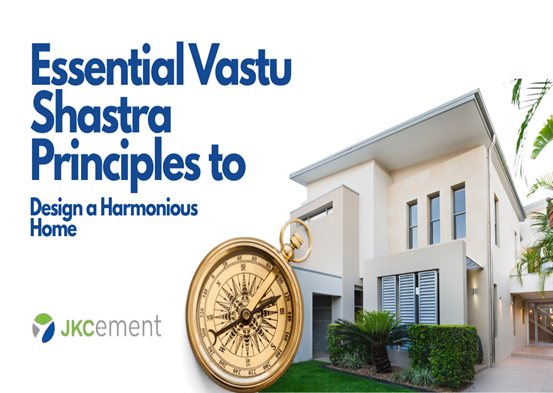When you enter a home, have you ever felt extremely positive or completely off? You’re not imagining it- that’s the house’s energy speaking with you. When you think about designing your dream home, our mind runs straight to the fun bits: picking out paint colours, planning the perfect living room layout, maybe even scrolling endlessly for kitchen inspiration. But no matter how well a home is decorated, its energy speaks much louder – how a space makes you feel is way more relevant. Does it bring you peace? Does it support your energy? Does it make you feel grounded?
This is where the science of energy – Vastu Shastra for home comes in.
This blog will simplify it. Vastu Shastra is basically India’s age-old architectural study. It’s about aligning spaces with directions, light, and energy so that your home doesn’t just look good but also feels good.
Why Vastu Shastra Still Matters Today
Architecture and design have transformed. Open courtyards have given way to compact apartments and mud floors to marble tiles. But the age-old principles of energy flow, sunlight, ventilation, and orientation have remained timeless.
What would you feel walking into a room with no sunlight, no windows, and a low ceiling? It would feel heavy. But, if you step into a bright, airy living space where the sunlight pours in through a window and there’s a gentle breeze, what happens? The energy changes instantly. That’s the difference Vastu design aims to create.
The Entrance: The Energyway
In Vastu, the entrance is considered the gateway for energy to flow into your home. It’s like inviting it before anything else. When you open your main door in the morning and are greeted by golden sunlight, it gives you an instant natural energy boost. For the entrance:
- North, northeast, or east directions are considered ideal. This is because these directions welcome morning light and fresh air.
- Keep your entrance clutter-free. No broken shoes, dusty plants, or squeaky hinges. It sets the tone for how energy and people enter your home.
The Living Room: Where Energy Collects
The living room is a space for bonding, happiness and conversations, where everyone gathers, whether it’s family, guests, or even just you stretching out after a long day. In a way, it’s the “heart” of the house.
According to a positive home Vastu plan, even if you live in a compact apartment, positioning can create a sense of breathing room in your living room layout.
- The living room must ideally sit in the east, north, or northeast zone. These directions invite natural light, which keeps the space vibrant.
- Place heavier furniture like sofas and cabinets in the west or south part of the room, leaving the north and east more open. This balances weight and makes the space feel more expansive.
The Kitchen: The Home’s Energy Generator
We often think of the kitchen in terms of recipes, storage, and countertop space. But from the Vastu point of view, the kitchen is where the energy of food is created – literally the fuel of the household.
- The southeast corner is considered the “fire zone,” making it the best spot for kitchens. If that’s not possible, Northwest is the next best option.
- Keep the cooking stove away from the sink. Fire and water are opposing elements, and putting them side by side creates friction, not just energetically, but practically too.
Bedrooms: Rest and Rejuvenation
Do you realise you spend nearly one-third of your life sleeping? Hence, the placement of bedrooms in a Vastu design is important.
- The southwest corner is ideal for the master bedroom, as it’s considered the most stable direction. Think of it like a tree’s roots; it anchors you.
- For children’s bedrooms, the west or northwest works well, giving them a sense of independence.
- Avoid placing the bed directly under a beam. Even if you don’t believe in energy disruptions, it creates a subconscious heaviness when you’re lying down.
The Pooja Room or Meditation Corner
Every home needs a quiet space, whether it’s for prayer, meditation, or simply a moment to yourself.
- According to Vastu Shastra for home, the northeast is the most sacred direction.
- Even if you can’t dedicate a whole room, a small corner with a lamp, some flowers, or a mat can become your energy recharge station.
Bathrooms and Toilets: The Overlooked Corners
We don’t usually give bathrooms the same design love as other spaces, but Vastu doesn’t ignore them.
- The northwest or southeast directions are recommended for toilets and bathrooms.
- Proper ventilation here isn’t just a Vastu principle—it’s good sense. Nobody likes damp, musty corners.
A Word on Apartments and Modern Homes
You might be wondering – what if my apartment doesn’t perfectly comply with all these Vastu principles? But Vastu isn’t about perfection; it’s about balance.
Small shifts like placing mirrors, plants, or even how you arrange furniture can make a difference.
For example, if your living room isn’t in the northeast but gets good natural light, you’re already energised with the spirit of Vastu. You can easily work with what you have.
Vastu Tips That Are Easy to Apply
These aren’t just “rules” but practices that also make your home feel fresher, lighter, and more comfortable.
- Keep the centre of your home as open as possible—it’s called the Brahmasthan, the energy core.
- Let in natural light and fresh air every morning, even if just for a few minutes.
- Place mirrors on north or east walls, never south.
- Use earthy tones in bedrooms for calmness, and brighter tones in the living room for energy.
- Keep plants like tulsi or money plant at entrances or balconies—they’re said to invite positive energy.
Designing a home isn’t only about brick, paint, and décor. It’s first about creating a space that brings in vibrancy and positivity that nurtures you. Vastu tips don’t mean you have to compromise on style or modern aesthetics. Most of its principles, like maximising light, ensuring airflow, and keeping spaces clutter-free, define modern designs perfectly.
Your home Vastu plan is a guiding hand towards balancing energy and harmony, to create a space where you feel rested, spend your days productively, and wind down in peace.
So, as you plan your dream home, while you get those perfect tiles and that chic living room layout, remember the placement of your kitchen, the openness of your rooms, and the energy of your bedroom. These define the actual comfort and vibe of your house. With just a little consideration, you can design a house that looks great, and one that feels as good.
FAQs
- Is it necessary to follow every single Vastu rule to have a good home?
Not at all. Vastu is an outline for creating balancing energies. Small shifts like more light, good airflow, or rearranging furniture can make significant transformations to your home energy – feel more balanced without a complete rebuild.
- My flat’s entrance faces west. Does that mean bad Vastu?
Not necessarily. East or north-facing entrances are preferred, but west-facing homes can also be harmonious with good ventilation, natural light, and a clutter-free entrance.
- Is Vastu Shastra a religious practice?
No, it’s a design and energy flow science.
- What is a simple Vastu tip that I can implement immediately?
Open your windows in the morning to let in natural light and fresh air. It is one of the easiest ways to use Vastu.
- Can Vastu affect my mood and health?
Yes. Vastu is about energy flow through directions. Openness, sunlight, and balance affect your mood and well-being in practical ways.
- What matters more – interior décor or Vastu design?
They go hand in hand. You can have the best furniture while placing it in Vastu-advised positions, giving you the best of both worlds.
Related posts
Categories
Recent Posts
Advertisment


